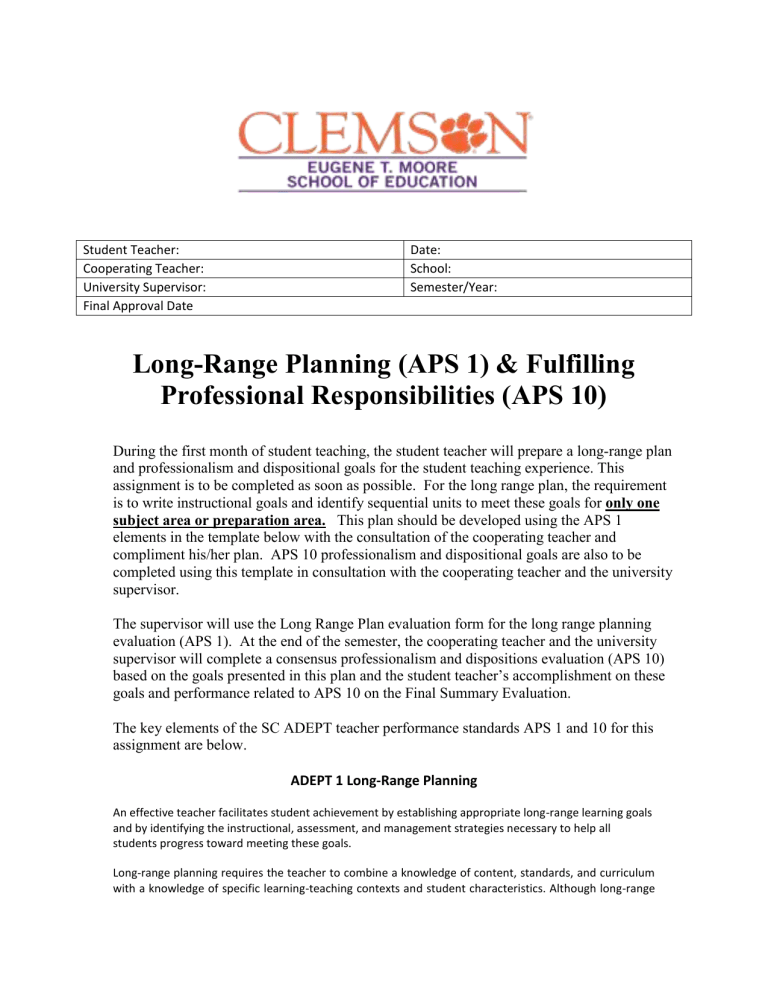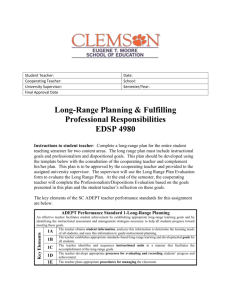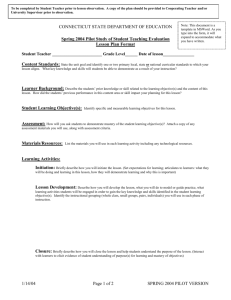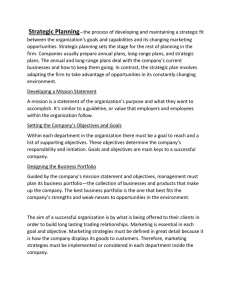Long Range Plan - Clemson University

Student Teacher:
Cooperating Teacher:
University Supervisor:
Final Approval Date
Date:
School:
Semester/Year:
Long-Range Planning (APS 1) & Fulfilling
Professional Responsibilities (APS 10)
During the first month of student teaching, the student teacher will prepare a long-range plan and professionalism and dispositional goals for the student teaching experience. This assignment is to be completed as soon as possible. For the long range plan, the requirement is to write instructional goals and identify sequential units to meet these goals for only one subject area or preparation area.
This plan should be developed using the APS 1 elements in the template below with the consultation of the cooperating teacher and compliment his/her plan. APS 10 professionalism and dispositional goals are also to be completed using this template in consultation with the cooperating teacher and the university supervisor.
The supervisor will use the Long Range Plan evaluation form for the long range planning evaluation (APS 1). At the end of the semester, the cooperating teacher and the university supervisor will complete a consensus professionalism and dispositions evaluation (APS 10) based on the goals presented in this plan and the student teacher’s accomplishment on these goals and performance related to APS 10 on the Final Summary Evaluation.
The key elements of the SC ADEPT teacher performance standards APS 1 and 10 for this assignment are below.
ADEPT 1 Long-Range Planning
An effective teacher facilitates student achievement by establishing appropriate long-range learning goals and by identifying the instructional, assessment, and management strategies necessary to help all students progress toward meeting these goals.
Long-range planning requires the teacher to combine a knowledge of content, standards, and curriculum with a knowledge of specific learning-teaching contexts and student characteristics. Although long-range
planning is an essential process for all teachers, long-range plans (LRPs) will differ according to variables such as content (i.e., subject matter, concepts, principles, process, and related skills) and context (e.g., setting, learning needs of the students). In developing LRPs, the teacher should work both independently and collaboratively. LRPs are dynamic documents that should be reviewed continuously and revised, as necessary, throughout the school year.
ADEPT Performance Standard 1-Long-Range Planning
An effective teacher facilitates student achievement by establishing appropriate long-range learning goals and by identifying the instructional assessment and management strategies necessary to help all students progress toward meeting these goals.
1A
The teacher obtains student information, analyzes this information to determine the learning needs of all students, and uses this information to guide instructional planning.
The teacher begins the long-range planning process by gaining a thorough understanding of students’ prior achievement levels, learning styles and needs, cultural and socioeconomic backgrounds, and individual interests. The teacher gathers this information from a variety of sources, including student records (e.g., permanent records, individualized education programs) and individuals such as other teachers, special-area professionals, administrators, service providers, parents, and the students themselves. From this information, the teacher identifies the factors that are likely to impact student learning. The teacher then uses this information to develop appropriate plans for meeting the diverse needs of his or her students.
1B
The teacher establishes appropriate standards-based long-range learning and developmental goals for all students.
The teacher’s goals are aligned with relevant federal, state, and local requirements and reflect the applicable grade-level academic standards. For preschool children and students with severe disabilities, the teacher’s goals align with appropriate developmental and/or functional expectations.
1C
The teacher identifies and sequences instructional units in a manner that facilitates the accomplishment of the long-range goals.
In this context, an instructional unit is a set of integrated lessons that is designed to accomplish learning objectives related to a curricular theme, an area of knowledge, or a general skill or process. Consistent with relevant federal, state, and local curriculum and/or academic standards, the teacher’s instructional units provide for appropriate coverage of the key themes, concepts, skills, and standards related to the subject area(s) and are designed to expose students to a variety of intellectual, social, and cultural perspectives. The sequence of the teacher’s units (as presented through timelines, curriculum maps, planning and pacing guides, and so forth) follows a logical progression, with an appropriate amount of time allocated to each instructional unit.
1D
The teacher develops appropriate processes for evaluating and recording students’ progress and achievement.
The teacher’s evaluation process includes the major formal and informal assessments to be used (e.g., observations, exams, research papers, performance, projects, portfolios) and the evaluation criteria for each.
The teacher’s evaluation methods are appropriate for the learning goals and the content. The evaluation criteria match state, local, and/or individually determined expectations for student progress and achievement. The teacher’s record-keeping system provides a confidential and well-organized system for storing, retrieving, and analyzing all necessary student data.
1E The teacher plans appropriate procedures for managing the classroom.
The teacher’s rules and procedures for managing student behavior, whether developed independently by the teacher or collaboratively with the students, are clearly stated, appropriate for the students, and consistent with school and district policies. The rules are stated in positive terms, when possible, and focus on behaviors rather than on students. The teacher’s procedures for managing essential noninstructional routines (e.g., transitioning between activities and/or subjects, taking roll, collecting student work, preparing learning centers or labs, retrieving instructional materials or resources) promote efficiency and minimize the loss of instructional time.
ADEPT Performance Standard 10-Fulfilling Professional Responsibilities
An effective teacher is an ethical, responsible, contributing, and ever-learning member of the profession.
10A The teacher is an advocate for the students.
The teacher collaborates with colleagues, administrators, and other student-oriented professionals (e.g., curriculum specialists, counselors, library media specialists, speech-language therapists, nurses) to determine the needs of his or her students and to plan and provide them with the appropriate learning experiences and assessments. The teacher establishes appropriate professional relationships with agencies, businesses, and community groups that support the well-being of students.
10B
The teacher works to achieve organizational goals in order to make the entire school a positive and productive learning environment for the students.
The teacher regularly attends and contributes to departmental meetings, faculty meetings, strategic planning sessions, and the like. The teacher actively supports the efforts of school organizations such as parent-teacher groups and school improvement councils. To the extent that is possible and appropriate, the teacher supports extracurricular activities that contribute to the overall learning and development of students (e.g., academic clubs, student council, athletics, cultural/artistic events).
10C The teacher is an effective communicator.
Both inside and outside the classroom, the teacher’s spoken and written language is clear, correct, and appropriate for each target audience (e.g., students, parents, colleagues, related professionals). The teacher communicates with parents/guardians on a regular basis about goals and expectations for student learning, behavioral rules and consequences, assignments, suggestions for supporting student learning at home, assessment results, and student progress and performance. The teacher responds appropriately to parental concerns. The teacher uses a variety of formats (e.g., telephone contacts, meetings, conferences, letters/newsletters, Web sites, report cards, notes, e-mails, interactive journals) to maintain effective and ongoing communication with others.
10D The teacher exhibits professional demeanor and behavior.
The teacher maintains a valid teaching certificate; complies with all professional, school, and district rules, policies, and procedures; and is cognizant of the policies set forth in the SDE publication Standards of Conduct for South Carolina Educators. The teacher’s performance is characteristic of a professional in terms of selfmanagement (e.g., responsibility, initiative, time management, appearance), ethical standards, and quality of work (e.g., completing required tasks in an accurate, timely, and effective manner).
10E The teacher is an active learner.
The teacher is a reflective practitioner who systematically collects, synthesizes, and evaluates studentachievement data in order to accurately identify his or her own professional strengths and weaknesses and to gain professional insight and vision regarding ways to enhance student learning. As a result of this selfassessment, the teacher collaborates with his or her supervisor(s) to develop an appropriate individualized professional growth plan. Additionally, the teacher regularly seeks out, participates in, and contributes to activities that promote collaboration and that support his or her continued professional growth (e.g., participation in professional associations, courses, conferences, workshops, seminars).
Section I: Provide Student Information (1.A)
Using the text above for ADEPT 1A as a guide, provide student information below.
Section II: Learning and Developmental Goals
Using the text above for ADEPT 1B as a guide, list and describe each goal.
Goals
(1.B)
Section III: Instructional Units and Assessments (1.C)
Using the text above for ADEPT 1C as a guide list the units in chronological order as they will occur in this course/content area(s).
Unit Topic or
Title
Correlated
Standards
Length
(# days or weeks)
Assessment(s)
(e.g., projects, quizzes, chapter/unit tests, homework assignments. Include weightings, if applicable.)
Section IV: Assessment Data (1.D)
Using the text above for ADEPT 1D describe your methods in this course/content area(s) for analyzing, evaluating, recording, and reporting student progress and achievement.
Section V: Classroom Management (1.E)
Insert your classroom management plan or rules, which should include your expectations regarding student behavior during instructional and non-instructional procedures and routines. Highlight the specific management demands of the course/content area(s) for this long-range plan.
Section VI: Professionalism/Dispositions Goals 10.A-E
Using the above text for ADEPT 10 as a guide, for each element A-E provide specific goals and describe how each of these goals will be accomplished.
10A.
10B.
10C.
10D.
10E.





